Beyond Reality: XR Technology’s Impact on Gaming
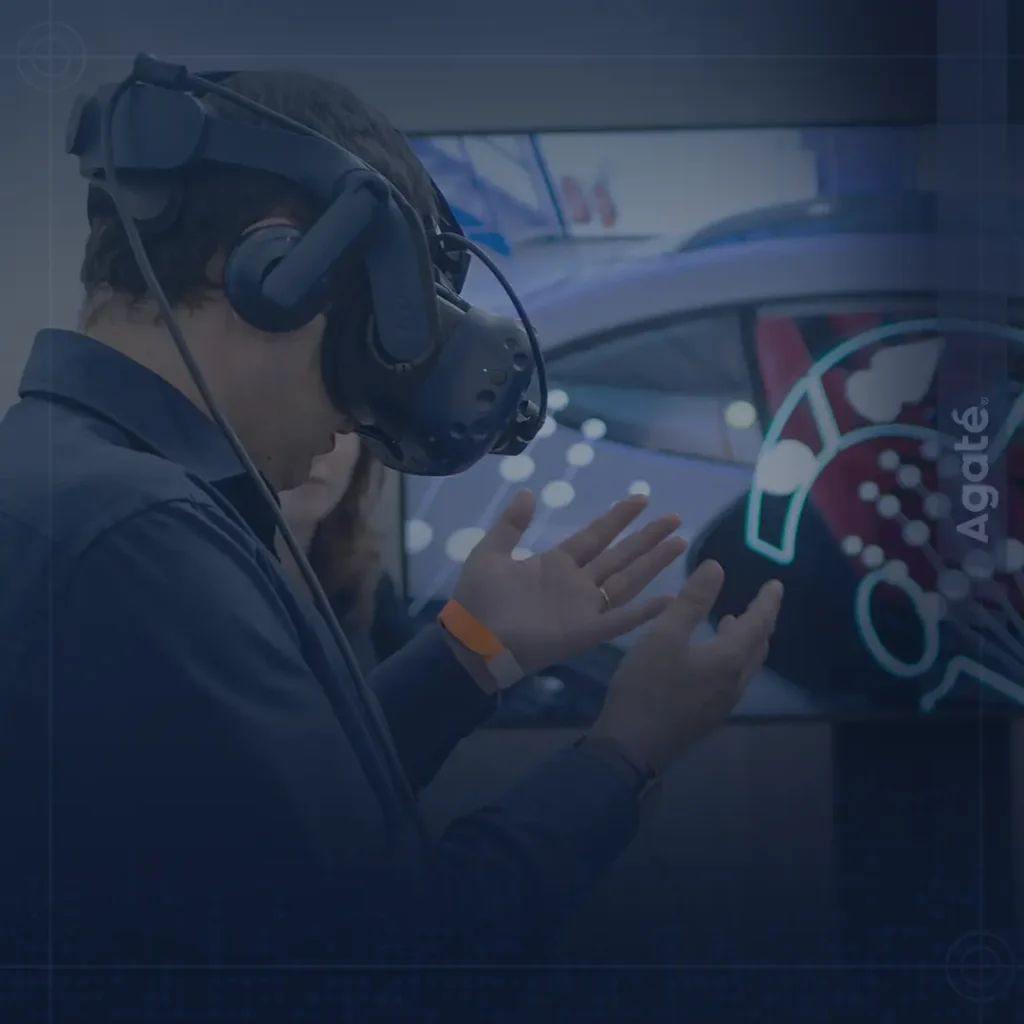
What is XR? Extended Reality (XR) is a groundbreaking technology revolutionizing the gaming industry by bridging the gap between the real world and the digital realm. At its core, XR creates an experience where players find themselves in a world where the boundaries between physical reality and digital fiction become indistinguishable. With Virtual Reality (VR), players are entirely immersed in virtual environments, freed from the constraints of the real world, and can interact with their surroundings in ways previously unimaginable. Augmented Reality (AR), on the other hand, overlays digital elements onto the real world, enriching the environment and providing users with real-time information and context-aware experiences. Mixed Reality (MR) combines aspects of both VR and AR, enabling users to interact with virtual objects while being fully aware of their physical surroundings. The Rise of Metaverse The concept of Extended Reality has been around for decades. Still, it was only recently that the technology reached a level of sophistication capable of delivering truly immersive gaming experiences. With the rise of VR headsets, AR-enabled smartphones, and MR devices, players can now enter a virtual world, interact with digital elements overlaid in the real world, and even merge the two seamlessly. One of the driving forces behind the rapid advancement of XR technology in gaming is the emergence of the metaverse. This interconnected digital universe allows players to transcend individual game experiences and enter a shared virtual space. In the metaverse, games become more than standalone titles, and they transform into platforms where players can socialize, create content, and even monetize their virtual endeavors. The Future of XR in Gaming Companies like Sony, Apple, and Microsoft have all acknowledged the immense potential of this interconnected digital universe and its profound impact on the future of technology and entertainment. As a result, these tech giants have embarked on ambitious journeys of research and development (R&D) in Extended Reality (XR) to stake their claim in this transformative landscape. Sony, in particular, took a meaningful step forward by committing a staggering 2 billion dollars to focus on game development and extended reality development. Sony’s decision to channel such significant financial resources into XR R&D is a testament to its dedication to remaining competitive. The company recognizes that XR represents the future of gaming and immersive entertainment, and investing in it is a strategic move to retain its position as a leading player in the gaming industry. With the gaming landscape constantly evolving, players are increasingly seeking more immersive and captivating experiences. XR technology offers precisely that experience, especially when combined with the Metaverse concept. By allocating substantial funds to XR R&D, Sony aims to tap into the growing demand for immersive gaming experiences beyond traditional gaming paradigms. The company aspires to create a seamless blend of virtual and real-world interactions, enabling players to explore and engage with vast virtual universes that mirror the real world. As XR technology continues to mature and permeate various markets, the sustainability of XR-based games is virtually guaranteed. As more consumers adopt XR devices and platforms, the potential user base for these games expands exponentially. This growing audience presents an opportunity for developers to create enduring and captivating gaming experiences that can withstand the test of time. The versatility of XR technology allows developers to explore many applications, ensuring that XR-based games can cater to diverse interests and preferences. The possibilities are virtually limitless, from action-packed adventures to educational simulations and social experiences. This adaptability attracts a broader audience and encourages player engagement and retention over extended periods. Choosing the Right Partner Partnering with experienced XR game companies is essential for developers looking to venture into Extended Reality. Agate has expertise in creating immersive and captivating XR games. From initial ideation to the final product, Agate offers collaborative opportunities for developers seeking to harness the power of XR technology. Are you looking for co-development, art services, or game porting? Look no further than Agate! Don’t hesitate to get in touch with us today and learn more about how we can help you take your project to exceptional heights.
Life At Agate: Embracing Our Company’s Culture
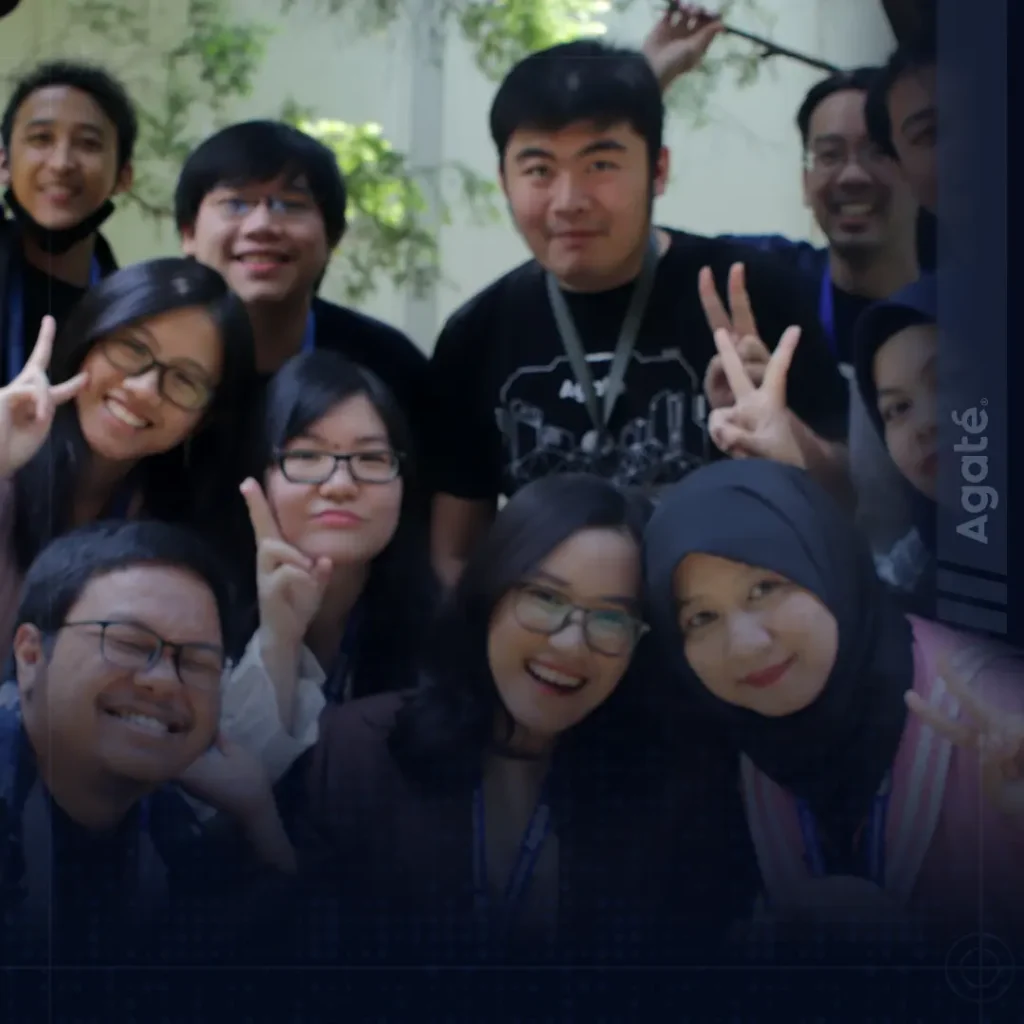
Have you ever wondered how a masterpiece is created by a group of diverse crews? It’s not only because of their individual skills but also their ability to collaborate and unite their efforts, resulting in greatly executed work. But how is it possible? At Agate, we believe our company culture plays a pivotal role in nurturing this dynamic. With our shared beliefs, values, and behaviors rooted in Agate’s culture, we strive to provide a home for a melting pot of diverse talents, cultures, and backgrounds, all coming together to create fun and enjoyable products and experiences. Agate’s Culture Our culture is deeply connected to its core principles: Positivity, Collaboration, Excellence, and Level Up. These guiding values shape every company’s operations, interactions, and achievements. Let’s explore more about this! Positivity At Agate, we wholeheartedly embrace positivity in our work, from how we perceive things to how we take action or react, and even our mindset and willingness to approach various challenges. However, this doesn’t mean we ignore negative emotions or pain and resort to toxic positivity. In this context, embracing positivity means reflecting on it through taking ownership, accountability, and responsibility for our actions instead of resorting to blaming, making excuses, or denying our part in any situation. Embracing positivity at Agate means that when we make a mistake, we don’t immediately seek others to blame; instead, we take ownership of our actions, admit our mistakes, and evaluate ourselves. Rather than shying away from accountability, we face it head-on, using each experience as an opportunity for growth and learning. This positive approach fosters a culture of continuous improvement and empowers us to work together in a supportive and constructive manner. We also prioritize our crew’s well-being by conducting regular well-being check-ups, ensuring they feel supported, valued, and equipped to embrace positivity and excel in their roles. Collaboration To create games, collaboration from various individuals across different divisions is essential. At Agate, we firmly believe we can achieve more when working together. To foster a culture of effective collaboration among our teams and departments, we strongly emphasize competence and empathy as cornerstones of our cooperative efforts. By understanding and appreciating each other’s perspectives, we build trust and respect that strengthens our working relationships. And that’s not all. We value and honor each team member’s expertise, recognizing that every contribution is essential to achieving our goals. Above all, we prioritize what is best for Agate and not our individual interests. We align our efforts towards the shared mission of creating exceptional gaming experiences. This collaborative spirit not only enhances the quality of our work but also nurtures a harmonious and productive work environment where creativity flourishes and innovative ideas thrive. Excellence Striving for excellence is at the core of everything we do, whether in our internal operations or when collaborating with external partners, clients, or customers. It means meticulously considering every decision, being receptive to fresh ideas, and consistently aiming to be the best version of ourselves. Internally, we harness our strengths and continuously strive for personal growth, fostering a culture where each team member is encouraged to excel. Externally, we prioritize the needs of our stakeholders and actively engage in problem-solving to provide the best solutions. As we aim for excellence, we also uphold the value of meritocracy, where everyone, regardless of their title or years of experience, is respected and recognized for their skills, creating an environment where valuable lessons can be learned from everyone involved. Our commitment to excellence is the driving force behind our unwavering dedication to delivering outstanding results and positively impacting all we work with. Level Up In both games and real life, leveling up holds immense value for personal and professional growth. Just as players find thrill in unlocking new content and mastering skills, we, too, believe that leveling up contributes to our continuous learning and development. With an open embrace of change as an inherent aspect of life, we maintain an enthusiastic thirst for knowledge, continuously seeking innovative approaches to enhance ourselves and fearlessly confronting challenges head-on. To support our crew’s ongoing learning and skill development, we provide 1-on-1 sessions for leaders and their team members to plan their career paths together and gain insights into their future growth and progression. We also believe in recognizing and rewarding excellence through grade-ups for deserving crew members. It’s all part of our commitment to fostering a culture of continuous improvement, empowering each crew member to excel in their respective roles. With a collective dedication to leveling up, we create an environment that nurtures personal growth and cultivates an exceptional team ready for even greater accomplishments in the future. At Agate, our culture is brought to life through the collective effort of our dedicated crew. To foster even stronger cohesion and collaboration among crews, we proactively facilitate crew alignment within the company. An example of these efforts is the implementation of the Talent Development Program, a comprehensive initiative designed to empower and nurture the skills of our crew. One of the programs is Team Building. What is team building? Let’s find out more about it below! Team Building Team Building is an integral activity at Agate, focused on enhancing intrapersonal relationships within teams and departments. Not only does it offer a chance for our crews to unwind and maintain their well-being, but it also promotes continuous growth and connectivity among our talented workforce. Recognizing that each team possesses its dynamics and preferences, we encourage them to tailor their team-building experiences to suit their unique needs. To facilitate this, we provide each team with a monthly budget, empowering them to design and customize their team-building activities that are both beneficial and enjoyable. A Glimpse of Team Building Activities at Agate. The beauty of team building lies in its flexibility. Some teams prefer engaging in online activities, and bonding over virtual games, while others opt for offline gatherings, and some even combine both to accommodate their schedules and preferences. Whether participating in virtual gaming sessions or enjoying fun outdoor
AI in Gaming: Benefits and Potential Opportunities
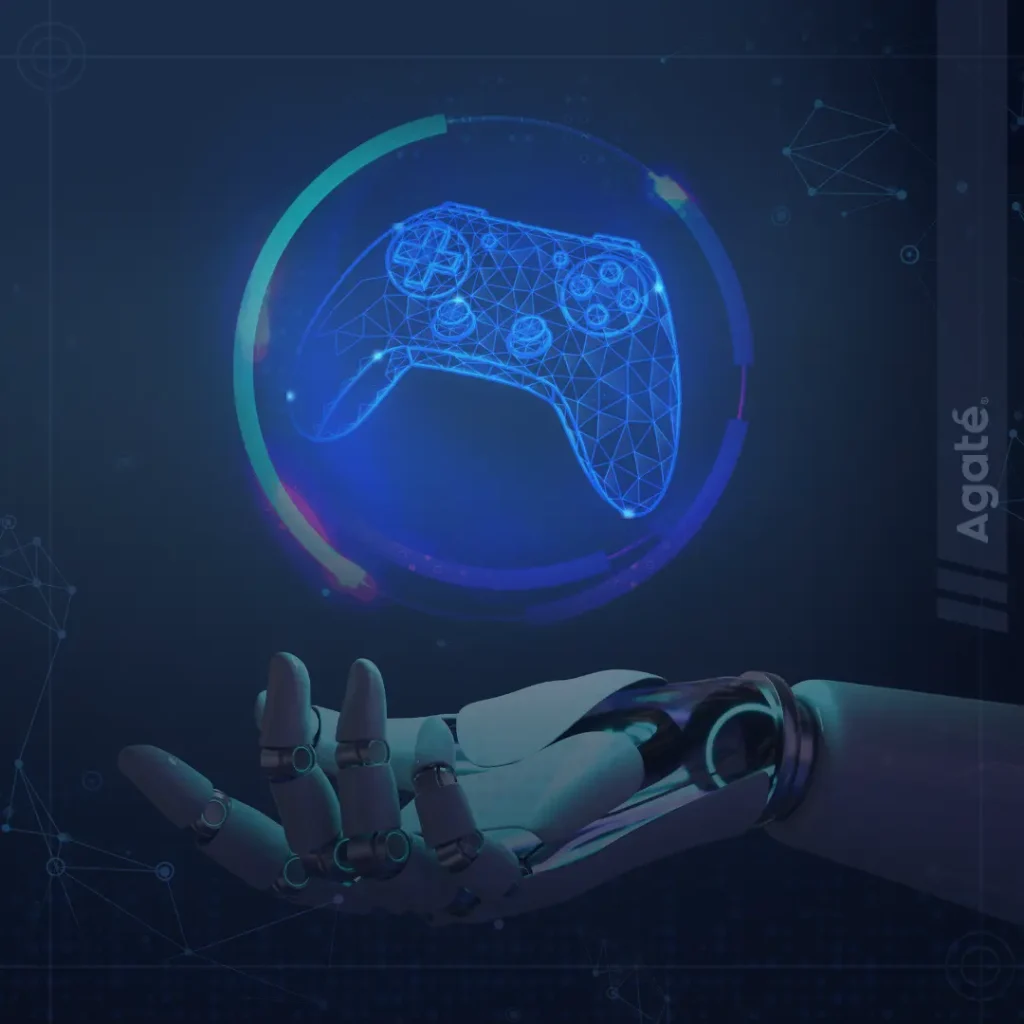
If you look deep down at how video games are developed, AI in gaming has always been around since the arcade days. Since the 1980s, games like Pacman used AI to control the ghosts/enemies that chase the player around the screen. However, AI has evolved a lot since then, and now it can also help create games, not just play them. AI can assist game developers in many ways, such as generating scripts, voices, and art for games. This could save time and money and allow developers to focus more on creativity and innovation. The gaming industry is one of the most lucrative and innovative sectors in the world, with a global market size of $200 billion in 2023, according to Grand View Research. Gaming is also a domain where artificial intelligence (AI) plays a crucial role, both as a tool for creating and enhancing game content and as a feature for providing immersive and adaptive experiences for players. Reducing Costs and Saving Time AI in gaming is that it can reduce costs and save time for game production. AI can automate or semi-automate some tasks that are tedious, repetitive, or time-consuming for human developers, such as generating textures, landscapes, animations, sounds, music, dialogues, stories, levels, maps, characters, rules, and so on. AI can also optimize or improve some aspects of game performance, such as rendering, loading, networking, debugging, testing, and so on. By using AI, game developers can save money and resources, and focus more on the core aspects of game design and development. According to UBS Securities analyst Kenji Fukuyama, the investment of money and time for such projects can be sliced in half by AI. He also stated that “Nothing can reverse, stop, or slow the current AI trend” in the gaming industry. There has been a rise in companies that are using AI to reduce costs and save time for game production, such as MoonlanderAI and Futureverse. MoonlanderAI recently announced the alpha release of its AI-powered platform for building immersive 3D games and experiences. The platform leverages updated large language models (LLMs), machine learning algorithms, and generative diffusion models to streamline the game development pipeline. The platform also includes a “text-2-game” feature that lets anyone develop a 3D game based on a text description. Futureverse has raised $54 million in a new round of funding in an effort to marry AI and the metaverse. Futureverse is an AI and metaverse technology and content company that aims to empower developers and users to create and engage with interoperable content and applications previously unavailable within the metaverse. The company’s technology platform includes a suite of proprietary AI content generation tools designed to enhance the music, objects, characters, and animations that make up the metaverse. The company has also launched AI-powered consumer games, such as AI League in cooperation with FIFA and Muhammad Ali – The Next Legends in partnership with Muhammad Ali Enterprises. Increasing Variety and Quality of Game Content AI can generate game content that is diverse, novel, realistic, coherent, balanced, and fun. AI can also learn from existing game content or data and generate new content that is similar or different. AI can also adapt or modify game content based on the player’s preferences, behavior, mood, or feedback. By using AI, game developers can create more engaging and satisfying games for players. Ubisoft has used AI to create realistic landscapes for its open-world games, while Sony has patented a system that can generate music based on the player’s mood and preferences. Some game developers have also used AI to create novel genres or mechanics for games, such as card games that use natural language processing or platformers that use generative adversarial networks. Enabling Personalization and Adaptation of Game Experiences AI in gaming can enable the personalization and adaptation of game experiences. AI can tailor game experiences to each individual player’s needs, wants, and goals. AI can also adjust game difficulty, challenge, and pace to match the player’s skill, progress, and interest. AI can also provide feedback, guidance, and support to the player to enhance their learning, motivation, and enjoyment. By using AI, game developers can create more immersive and interactive games for players. For instance, Microsoft has used AI to make its games more accessible for players with disabilities, such as using eye-tracking technology to control games or using speech recognition to transcribe dialogues. Some game developers have also used AI to create adaptive narratives or characters for games, such as interactive fiction that uses natural language understanding or role-playing games that use emotional models. Fostering Creativity and Innovation in the Gaming Industry AI can inspire human developers and designers to explore new ideas, concepts, and genres for games. AI can also collaborate with human developers and designers to co-create game content or features. AI can also challenge human developers and designers to improve their skills, knowledge, and methods for game design and development. By using AI, game developers can create more original and innovative games for players. Recently, Agate’s R&D team has been exploring the use of procedural content generation (PCG) techniques to enhance its game development services. PCG is the process of using an AI system to author aspects of a game that a human designer would typically be responsible for creating, from textures and natural effects to levels and quests, and even to the game rules themselves. PCG creates game content algorithmically rather than manually, which can save time, resources and increase variety and replayability. PCG allows Agate’s game designers to create various types of game content using PCG algorithms, empowering them with more creative freedom and flexibility while ensuring the quality and coherence of the generated content. Conclusion AI is a game-changer for the gaming industry, but it also comes with some challenges and controversies. The gaming industry needs to embrace AI as a tool for creating and enhancing game content, but also as a feature for providing immersive and adaptive experiences for players. However, the gaming industry also needs to
Breaking the Barriers: Augmented Reality in Gaming
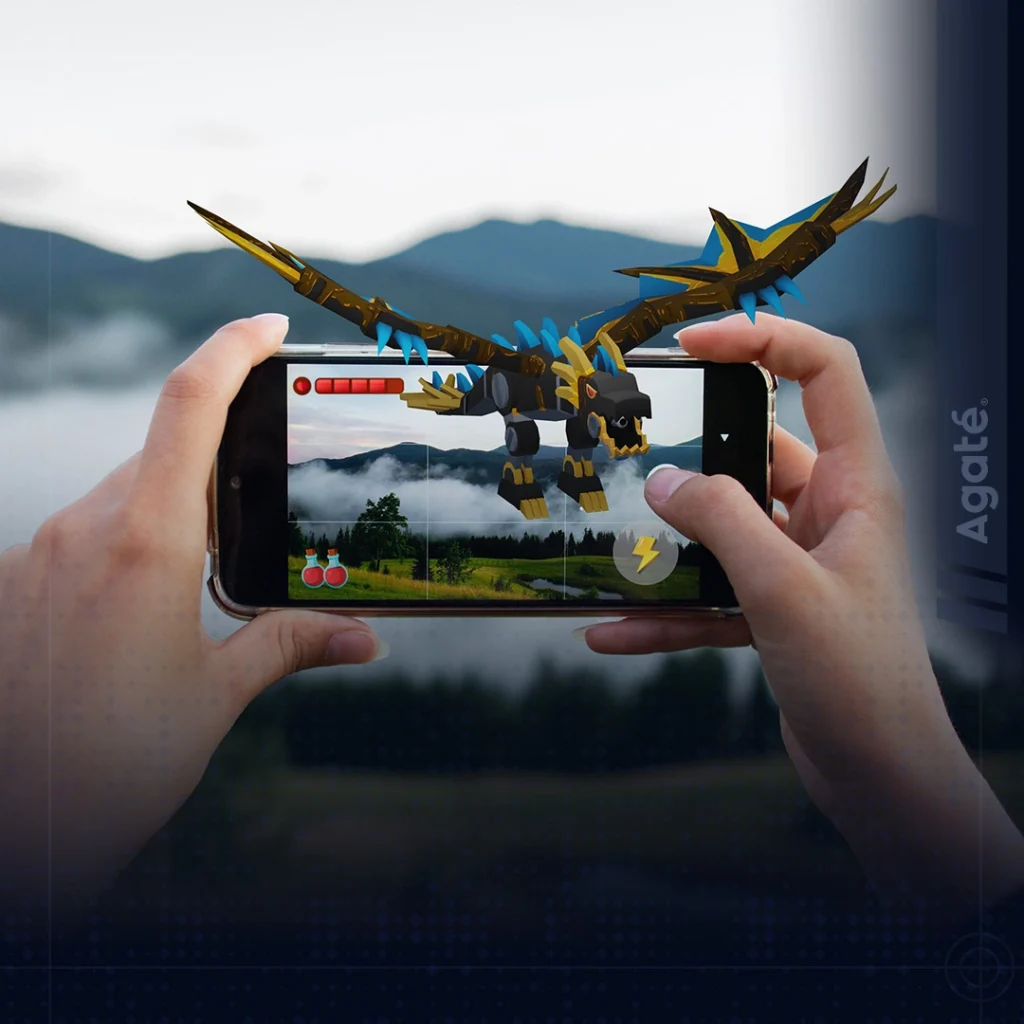
“Bringing games to life.” What comes to your mind when you hear that phrase? Nowadays, it can be interpreted in at least two ways. First, it just how traditionally refers to the creation of games and how games are brought to life by being delivered to be played all around the world. But second, it can now take on a literal interpretation through Augmented Reality (AR). With AR, you can bring your virtual game world to a real-life environment! This is just an example of how AR has revolutionized various industries, including marketing, beauty, food and beverage, and, notably, the gaming industry. Research indicates that the AR market is poised to surpass USD 50 billion by 2024, showing sustained growth and presenting new possibilities for AR utilization in many sectors. However, it is the impact of AR in gaming that truly captures our attention. The question arises: what groundbreaking developments has AR brought to this dynamic industry? Join us as we embark on an exploration of AR in the gaming industry! What is AR? AR is an interactive technology that overlays digital information and virtual objects onto the real-world environment, enhancing our perception of reality by blending the physical and digital worlds. It provides users with an enriched and interactive experience. AR technology typically utilizes devices such as smartphones, tablets, or specialized AR glasses to deliver these augmented experiences. In AR, virtual elements are superimposed onto the real-world environment in real time. This can include 3D objects, text, images, videos, or interactive elements that appear as if they exist in the user’s real surroundings. AR systems use techniques like computer vision, depth tracking, and sensor fusion to understand the user’s environment and seamlessly integrate digital content into it. AR enhances gaming experiences by allowing virtual objects and characters to interact with the real world. Players can play AR games in real locations, where the game elements require physical movement and exploration, adding a sense of fun to their experience. They can interact with these objects and experience gameplay elements that seamlessly blend with their surroundings. AR gaming often utilizes the camera and sensors on mobile devices to track the user’s position and orientation, enabling precise positioning and alignment of virtual objects in the real world. While AR and VR gaming may appear similar at first glance, they offer distinct experiences. In AR gaming, virtual elements are overlaid in the real-world environment, allowing players to interact with virtual objects while remaining aware of their physical surroundings. This type of gaming occurs in the player’s actual environment, integrating real-world objects and locations into the gameplay. On the other hand, VR gaming immerses players in a completely virtual environment, replacing the real world. By wearing VR headsets, players are transported to a virtual space where they can fully engage with the digital surroundings. How AR Revolutionized Gaming Enhanced Immersive Experience In today’s gaming landscape, developers are constantly striving to deliver immersive experiences that captivate players. From advancements in character development and stunning graphics to dynamic audio design, every aspect is meticulously crafted to create the perfect ambiance. AR is also an example of this. By bringing AR into gaming, it leverages the capabilities of modern devices to overlay digital elements onto the player’s physical surroundings, effectively merging the virtual and real-life environment. AR breaks the barrier between the screen and the player, enabling them to see virtual objects and characters in the context of their real-world surroundings. Imagine battling virtual monsters in your living room or solving puzzles that appear on your tabletop. AR brings the game directly into the player’s physical space, transforming the way they perceive and engage with the gameplay. One of the key advantages of AR in gaming is its ability to provide a realistic and immersive experience. By integrating virtual elements into the real world, AR creates a sense of presence and depth that was previously unattainable. Players can see virtual objects coexisting with their immediate environment, generating a seamless blend between the physical and digital realms. AR not only enhances gameplay but also sparks the imagination and curiosity of players as they explore new possibilities within their own surroundings. Encourage Physical Movement AR brings an exciting new dimension to the gaming industry by encouraging players to stay active and engage in physical movement. Unlike traditional gaming experiences, some AR games incorporate real-life locations into the gameplay, motivating players to explore their surroundings. AR games often utilize location-based technologies, such as GPS, to provide players with a contextually relevant and location-specific gaming experience. This means that players may need to physically move to different areas or landmarks to progress in the game or unlock specific features. For example, an AR game may require players to explore their neighborhoods to collect virtual items or complete challenges tied to real-world locations. By encouraging physical movement, AR games offer a unique blend of entertainment and exercise. AR gaming brings a fresh perspective to the gaming industry by promoting physical movement and encouraging players to explore their environments. It breaks the traditional notion of gamers that often spend their time sitting and playing inside with their consoles, PCs, or mobile devices. The Future of AR in Gaming The future of AR in gaming holds tremendous potential for innovation and advancement. With improved hardware, enhanced realism, and advanced gameplay mechanics, AR gaming will offer more immersive and realistic experiences. The integration of multiplayer and social features will foster real-time interaction and community building. AR gaming will also integrate real-world data, creating personalized and context-aware experiences. Additionally, AR will have a significant impact on education and training, providing interactive and experiential learning opportunities. Furthermore, the convergence of AR with other emerging technologies like AI and cloud computing will enable dynamic and personalized gaming experiences. AI algorithms can adapt the gameplay based on player behavior and preferences, creating unique and tailored experiences for each individual. Overall, the future of AR gaming is a promising one. It will continue to offer players unprecedented levels of
History of Multiplayer Games: From LAN to Cloud Gaming
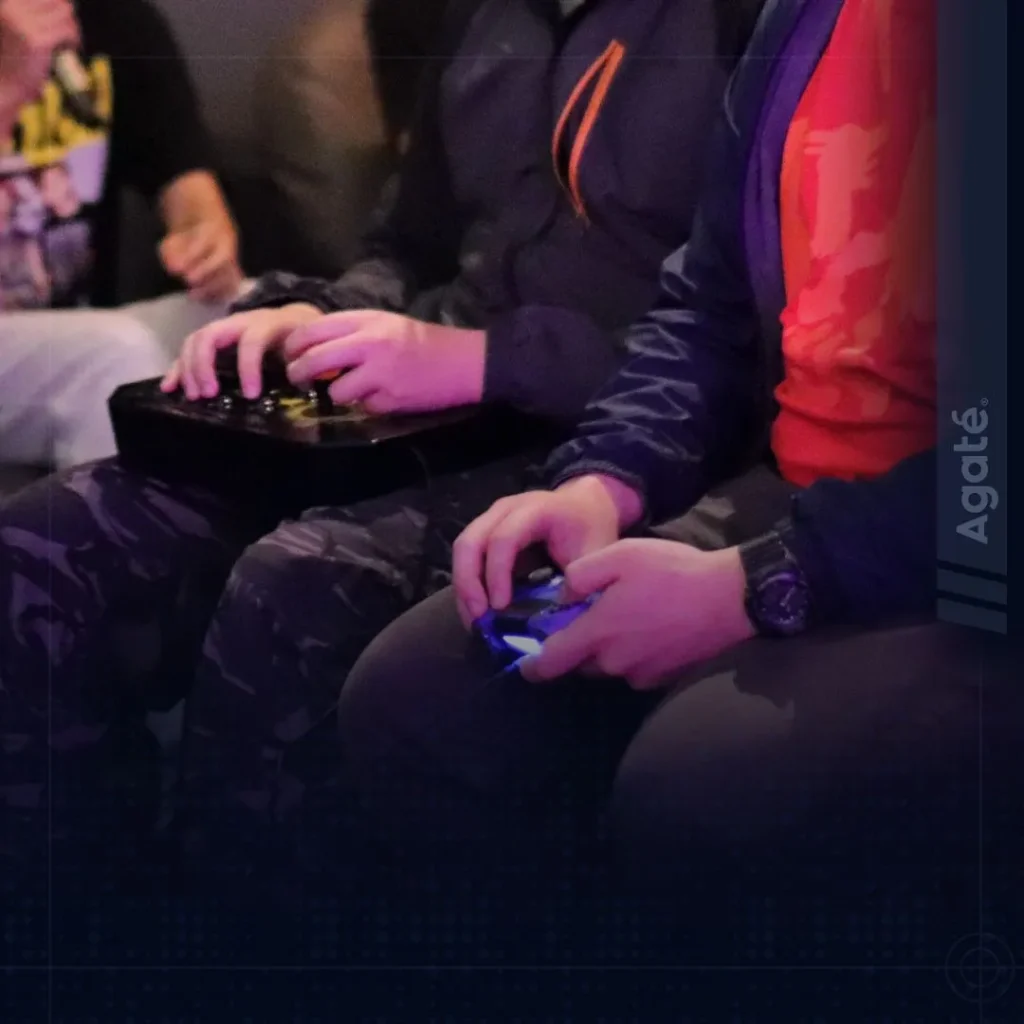
Ah, yes, multi-player games. We all know them, we all love them, and we’ve all spent way too much time and even money on them. But do you ever wonder how multiplayer games came to be and how they changed over time? If you answered yes to any of these questions, then you came to the right place! In this article, we will take you on a journey through the history of multiplayer games, from their humble beginnings to their amazing present and future. So grab your snacks, log in, and let’s begin! The First Multiplayer Games The history of multiplayer games goes way back to the dawn of video games when some of the first games were made for two players to play on the same device. One of the earliest video games was Tennis for Two, created in 1958 by William Higinbotham at the Brookhaven National Laboratory. It was a simple tennis simulation game that used an oscilloscope as a display and two controllers with knobs and buttons. The game was meant to show off the lab’s equipment and to entertain visitors. It was one of the first games to use a graphical display and to simulate physics. It was also one of the first games to cause arguments over who won and who cheated. Play Video Another early video game was Spacewar!, created in 1962 by Steve Russell and others at MIT. It was a two-player space combat game that used a PDP-1 computer as a platform and a vector monitor as a display. The game featured two spaceships that could shoot projectiles at each other and maneuver around a star that exerted gravity. The game was widely shared among academic institutions and influenced many later games. It was also one of the first games to cause eye strain and carpal tunnel syndrome. The first examples of multiplayer real-time games were developed on the PLATO system, a networked computer system designed for education, in the early 1970s. Some of the multiplayer games developed on this system were Empire, a strategic war game; Spasim, an early first-person shooter; and Airfight, a flight simulator. These games were revolutionary because they allowed multiple players to play together in real-time over a network. They were also revolutionary because they caused many students to skip classes and stay up all night. The first arcade video games also featured multiplayer modes, where players could take turns or play simultaneously on the same machine. Some of the popular arcade multiplayer games were Pong, a table tennis game; Gun Fight, a western-themed dueling game; and Breakout, a brick-breaking game. These games were fun because they were easy to play and addictive. They were also fun because they allowed players to show off their skills and trash-talk their opponents. The Rise of Networked Multiplayer Games As computers became more powerful and affordable, and as networking technology improved, multiplayer games started to use different computing systems connected by local area networks (LANs) or wide area networks (WANs), such as the Internet. This allowed players to play together over greater distances and with more players. One of the pioneers of networked multiplayer games was MUD (Multi-User Dungeon), created in 1978 by Roy Trubshaw and Richard Bartle at Essex University. It was a text-based adventure game that allowed multiple players to explore a virtual world, interact with each other and with non-player characters, and create their own content. MUD was inspired by Adventure, a single-player text adventure game based on Dungeons & Dragons, and Zork, another text adventure game that featured a complex parser and rich descriptions. MUD was influential in creating the genre of massively multiplayer online role-playing games (MMORPGs). MUD was also influential in creating many online friendships, romances, rivalries, and dramas. To get from Pong to peer-to-peer first-person shooters, we need to jump way forward to 1973 when Maze War was released. A year after Pong, Maze War was a real first-person shooter that connected computers directly to each other, allowing two players to hunt each other down and engage in twisted battles. It was developed by NASA, of all places. In these early days, multiplayer was achieved by hooking up serial cables between two machines, and the internet as we know it wouldn’t become a thing until much later, in 1991. If you delve into gaming history of any kind, it isn’t long before you run into Doom. In 1993, id Software created a cluster bomb of industry-changing innovations, and networked FPS multiplayer was one of them. Unlike “Maze War” 20 years previously, Doom could connect up to four players over a network, think four actual PCs connected to a local area network or LAN, to play cooperatively or competitively. Here’s a fun fact Did you know that many FPS lingos came from Doom?Doom popularized the terms “frag”, “gib”, “camp”, “spawn”, “lag”, “cheat”, “rage quit”, and many others. The Transition to Online Multiplayer Games As the Internet became more accessible and widespread in the mid-1990s, multiplayer games started to use online services and platforms to facilitate matchmaking, communication, and community building among players. Online multiplayer games also became more diverse and complex, offering various genres, modes, features, and experiences. One of the first online multiplayer games was Ultima Online, created in 1997 by Origin Systems. It was an MMORPG that expanded on the Ultima series of single-player role-playing games. Ultima Online allowed thousands of players to coexist in a persistent medieval fantasy world, where they could create their own characters, explore the land, engage in combat, craft items, trade goods, join guilds, participate in events, and interact with other players and NPCs. Ultima Online set many standards for MMORPGs and influenced many later games. Ultima Online also set many records for online gaming, such as the largest virtual world, the most concurrent players, and the most in-game murders. Another early online multiplayer game was QuakeWorld, created in 1996 by id Software as an update to Quake, another first-person shooter game. QuakeWorld introduced client-side prediction
Indulging in Romantic-Fantasies: The Allure of Otome Games

Various genres have evolved with the progression of game development, introducing previously unimagined concepts. Now, games have emerged as a powerful medium for storytelling, offering a unique advantage over films and other media by allowing players to assume the role of the protagonist and actively engage with the narrative. These interactive experiences encompass various genres, including adventure, horror, and more. In this article, we’re diving into the delightful realm of games that put romance front and center. Otome games, which translates to “maiden games,” are story-based video games primarily targeted toward female audiences. These games typically revolve around a central female protagonist who interacts with a cast of charming and diverse male characters, forming relationships and ultimately determining the course of the story through their choices. Otome games often feature intricate narratives with multiple branching paths, allowing players to shape their romantic destinies. Why are Otome Games Popular? Engaging Storylines One of the primary reasons for the popularity of otome games is their captivating storytelling. These games offer intricate plots filled with romance, mystery, and fantasy elements, allowing players to become fully immersed in the world and emotionally invested in the characters’ journeys. The depth and complexity of the storytelling in otome games are noteworthy. As players progress through the game, they encounter unexpected plot twists, character revelations, and dramatic confrontations that heighten the emotional stakes. The carefully constructed storylines evoke many emotions, ranging from joy and excitement to heartbreak and sorrow, leaving players deeply invested in the outcomes and eager to discover the next chapter. Empowering Female Protagonists Otome games empower players by placing them in the shoes of a strong and independent female protagonist. This empowerment appeals to a diverse audience, providing an opportunity to experience different perspectives and forge relationships with well-rounded and memorable characters. The presence of empowered female protagonists in otome games is a refreshing departure from traditional narratives that often portray women in passive or secondary roles. By embodying these dynamic and resilient characters, players can explore their strengths and agency. They can witness firsthand the protagonist’s growth, resilience, and ability to overcome obstacles, which can be empowering and inspiring. The appeal of playing as a female protagonist extends beyond gender boundaries. Otome games have attracted a diverse audience, including players of various genders and backgrounds. This inclusive approach allows individuals from different walks of life to engage with the game’s narratives and characters, fostering empathy, understanding, and appreciation for different perspectives. Romantic Escapism Romantic escapism is a cherished aspect of otome games that captivates players and offers them a haven to indulge in their romantic fantasies. These games provide a unique opportunity for players to embark on virtual romantic journeys, immersing themselves in a world of love, passion, and emotional connections. Within the virtual setting of otome games, players can experience the exhilarating thrill of courtship. They can engage in flirtatious banter, heartwarming and sometimes humorous interactions, and witness the gradual development of romantic relationships. The anticipation and excitement accompanying wooing and being wooed evoke a sense of butterflies in the stomach, allowing players to relish in the joy of romantic pursuits. Emotional Investment Emotional investment is a profound aspect of otome games that distinguishes them as a unique form of interactive entertainment. These games elicit a wide range of emotions from players, forging a deep connection and empathy between the player and the virtual world. Otome games also have a knack for creating memorable and poignant moments that tug at heartstrings. These moments can range from tender confessions of love to heart-wrenching moments of sacrifice or loss. The well-crafted dialogues, poignant visuals, and poignant soundtracks work harmoniously to create an immersive experience that touches the player’s emotions and leaves a lasting impression. Creating a Good Otome Game Well-Developed Characters The key to crafting an exceptional otome game lies in creating compelling and relatable characters. Each character should possess unique personalities, backstories, and motivations, allowing players to form emotional attachments and establish deep connections. Meaningful Choices Otome games thrive on player agency, where the choices made by the protagonist shape the narrative and determine the outcome of their romantic journey. Providing meaningful decisions impacting the story and character relationships is crucial for player engagement and immersion. Narrative Depth and Diversity Play Video Memories, an otome game that offers various stories. Otome games should offer a rich and diverse range of storylines. Including different genres, settings, and character archetypes ensures a wider appeal and allows players to explore various romantic paths and experiences. Attention to Detail Polished visuals, quality voice acting, and a well-composed soundtrack contribute to the overall immersion and enjoyment of an otome game. Attention to detail in the art, sound design, and localization enhances the player’s experience and helps bring the world and characters to life. Post-Release Support The latest tale in the Celestia Chain of Fate chronicles To foster longevity and continued interest in otome games, developers must provide regular updates, downloadable content, and engagement with the community. Creating additional storylines, characters, or bonus content can keep players engaged and excited, ensuring the game’s longevity. Memories: My Story, My Choice If you want to immerse yourself in captivating Otome games with intriguing settings, look no further than Memories: My Story My Choice. This game offers many compelling stories that will undoubtedly enthrall you. Whether you enjoy timeless fairy tales such as Red Onion, White Onion, and Hansel and Gretel, or prefer original stories that weave intricate narratives like Dream! Fashion Star and Celestia Chain of Fate, Memories have something for everyone. Recently, Agate, the renowned game developer, has delighted fans by releasing the much-anticipated sequel to Celestia Chain of Fate, which happens to be one of the most popular storylines within the Memories universe. This captivating sequel continues the enchanting tale and provides players with new adventures, challenges, and opportunities for romance. Check out the mesmerizing trailer. Play Video You can download Memories: My Story, My Choice for free on your device. Play it now! Are you looking for co-development, art
The Best of Both Worlds: Action-Adventure Genre
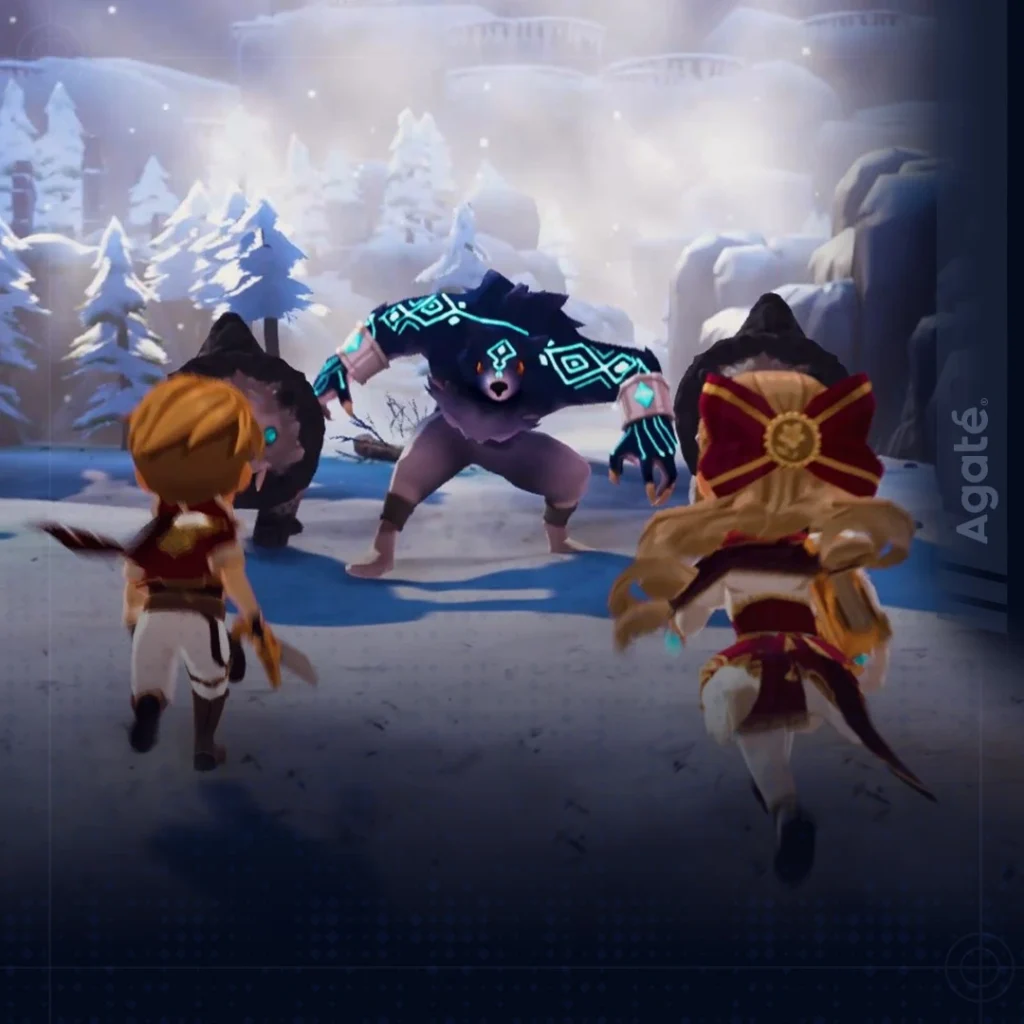
The gaming industry offers a wide range of genres for players to explore, making it an exciting world to dive into. With a diverse community of players, there are abundant choices available to cater to various preferences and needs. Horror games provide an adrenaline rush for those seeking intense and thrilling experiences. Additionally, there are options such as racing games and many more, ensuring that there’s something to suit everyone’s tastes. Moreover, with the flexibility of porting games to different platforms, including consoles, PCs, and mobile devices, players have an even greater array of options at their disposal. The gaming industry continues to evolve, constantly providing new and exciting ways for players to immerse themselves in unforgettable adventures. Among the diverse range of game genres, we also find the intriguing world of hybrid genres. Have you ever come across or played games from these hybrid genres? One prime example of a hybrid genre is the action-adventure game. So, let’s dive right in and explore this exciting blend of gameplay! Action-Adventure Games Vathirian Arc: Hero School Story 2 from Agate Action-adventure games have carved a special place in video games, enticing players with their unique blend of action-packed sequences and immersive exploration. By combining elements from both action and adventure genres, these games offer an exciting gaming experience that captivates players from start to finish. By combining elements from action and adventure, these games typically involve a mix of intense action sequences and exploration within an immersive and often expansive world. In an action-adventure game, players get to embark on a journey filled with challenges, quests, and obstacles to overcome. These games often feature a rich narrative that drives the player’s progression and unfolds as they delve deeper into the game world. If you’re into action-packed games, chances are you’ll also enjoy the action-adventure genre. In action-adventure games, the action elements revolve around combat, where players engage in battles against enemies using various weapons, skills, and tactics. These combat sequences demand quick reflexes and strategic thinking to overcome challenges. On the other hand, the adventure aspects of these games emphasize exploration, puzzle-solving, and uncovering secrets within the game world. Players are encouraged to explore their surroundings, interact with objects, and solve puzzles to progress through the game’s storyline. This exploration often rewards players with new abilities, items, or story revelations. Action-adventure games can feature a wide range of settings, from ancient mystical realms to futuristic sci-fi worlds and everything in between. These choices cater to a broader audience preferences and interests. Elements in Action-Adventure Games Vathirian Arc: Hero School Story 2 from Agate Action-adventure games have carved a special place in video games, enticing players with their unique blend of action-packed sequences and immersive exploration. By combining elements from both action and adventure genres, these games offer an exciting gaming experience that captivates players from start to finish. By combining elements from action and adventure, these games typically involve a mix of intense action sequences and exploration within an immersive and often expansive world. In an action-adventure game, players get to embark on a journey filled with challenges, quests, and obstacles to overcome. These games often feature a rich narrative that drives the player’s progression and unfolds as they delve deeper into the game world. If you’re into action-packed games, chances are you’ll also enjoy the action-adventure genre. In action-adventure games, the action elements revolve around combat, where players engage in battles against enemies using various weapons, skills, and tactics. These combat sequences demand quick reflexes and strategic thinking to overcome challenges. On the other hand, the adventure aspects of these games emphasize exploration, puzzle-solving, and uncovering secrets within the game world. Players are encouraged to explore their surroundings, interact with objects, and solve puzzles to progress through the game’s storyline. This exploration often rewards players with new abilities, items, or story revelations. Action-adventure games can feature a wide range of settings, from ancient mystical realms to futuristic sci-fi worlds and everything in between. These choices cater to a broader audience preferences and interests. Compelling Story A compelling story is a fundamental aspect of action-adventure games, immersing players in captivating game worlds and forging emotional connections with the protagonist’s journey. Through a well-developed narrative, players become invested in the characters and their struggles, fostering a sense of connection, empathy, and attachment. The story also serves as a driving force, providing players with purpose and motivation to advance through the game. Clear objectives, quests, and goals guide players, encouraging them to continue exploring and engaging in the game world. By balancing the thrill of action with these emotional connections and memorable experiences, the story enhances the overall enjoyment of the game. Interesting Character Character is also an element that contributes to the overall experience and enjoyment of the gameplay. When players can relate to or emphatize with the protagonist, it enhances their engagement and investment in the game. Characters in action-adventure games often possess unique abilities, skills, or powers integral to the gameplay mechanics. These special traits enable players to overcome obstacles, solve puzzles, and engage in combat encounters. The character’s abilities provide a sense of empowerment and progression as players unlock and upgrade their skills throughout the game. Side Activities Side activities in action-adventure games offer players an extended gameplay experience, allowing them to immerse themselves in the game world for longer periods. These activities provide additional content and challenges that increase the game’s overall longevity, enticing players to return and explore even after completing the main story. Engaging in side activities leads to discovering hidden areas, unique landmarks, and interactions with various non-playable characters. This exploration enhances the sense of immersion and discovery, breathing life into the game world and making it feel vibrant and dynamic. Examples of side activities in action-adventure games include engaging in side quests or missions that provide additional storylines, searching for collectibles scattered throughout the game world, participating in mini-games that offer unique gameplay experiences, interacting with side characters to uncover deeper narratives,
NFT Marketplace: The Future of Gaming and Art
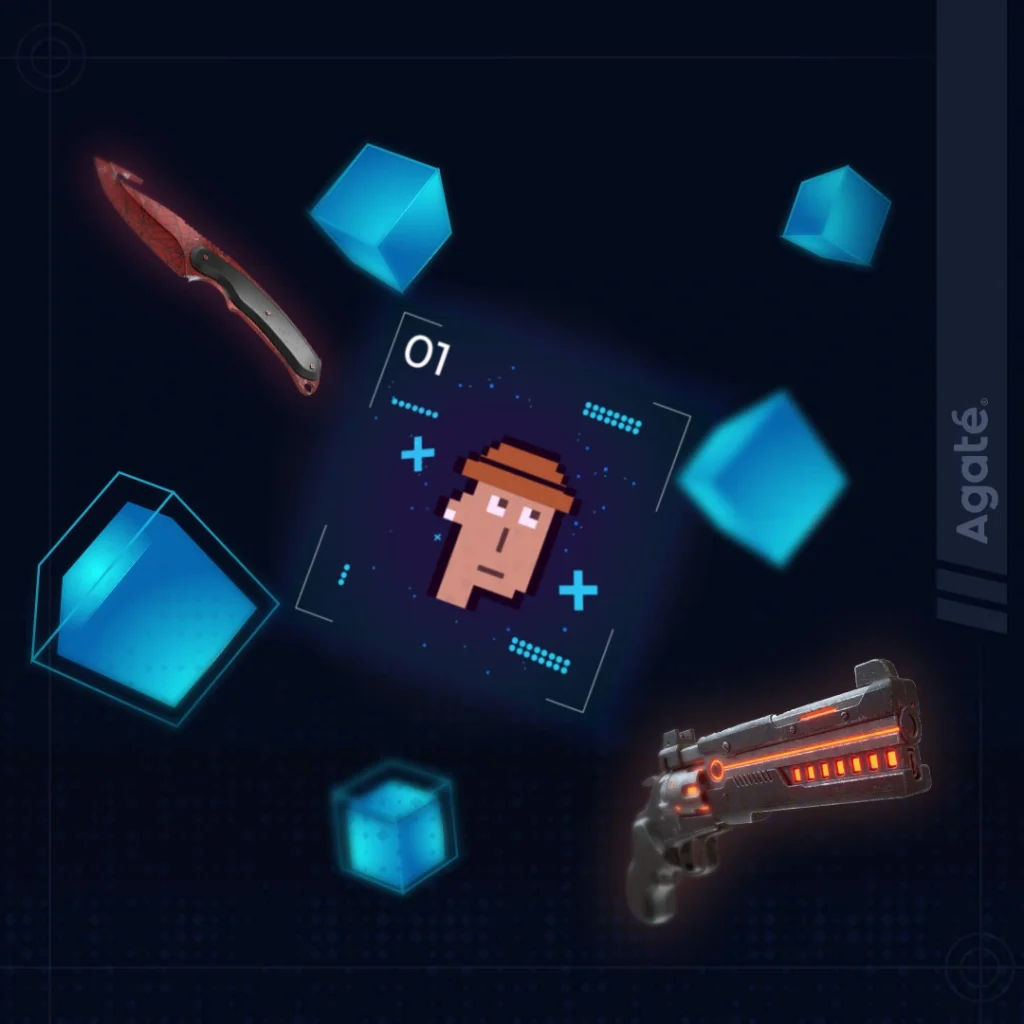
The world of gaming and art has always been dynamic and ever evolving. Over the years, we have witnessed technological advancements that have transformed both industries. One of the latest and most significant developments is the emergence of Non-Fungible Tokens (NFTs) and their corresponding marketplaces in web3. NFTs have taken the digital world by storm, offering new opportunities for creators, collectors, and investors alike. Let’s explore how NFT marketplaces are shaping the future of gaming and art, revolutionizing the way we create, buy, and sell digital assets. Understanding NFTs Before we dive into the NFT marketplace, let’s first understand what NFTs are. Unlike cryptocurrencies such as Bitcoin or Ethereum, which are fungible and can be exchanged on a one-to-one basis, NFTs are unique and indivisible tokens. Each NFT represents a specific digital asset, whether it’s an artwork, a video clip, a piece of music, or even a virtual item within a game. These tokens are built on blockchain technology, providing proof of ownership, authenticity, and scarcity. The Intersection of NFTs, Gaming, and Art Gaming and art have always shared a close relationship, often influencing and inspiring each other. With the NFTs, this relationship has reached new heights. NFTs have introduced the concept of true ownership and scarcity to the digital realm, allowing gamers and artists to monetize their creations like never before. In the gaming industry, NFTs have opened up a world of possibilities. Game developers can now create unique and valuable in-game assets, such as rare weapons, skins, or characters, as NFTs. Players can purchase these NFTs, truly owning and trading them in a secure and transparent manner. This creates a new economy within games, where players can invest in valuable assets and even make a profit by selling them on NFT marketplaces. Similarly, NFTs have transformed the art world by enabling artists to showcase and sell their digital artwork as unique tokens. This has revolutionized the concept of digital ownership, allowing artists to retain control over their creations and monetize their work directly. NFT marketplace provides a platform for artists to reach a global audience and connect with collectors who are willing to invest in their digital artwork. The Benefits of NFT Marketplace NFT marketplace act as the bridge between creators and buyers, facilitating the trading and exchange of digital assets. These marketplaces offer several benefits that contribute to their growing popularity: Accessibility and Global Reach: NFT marketplaces are accessible to anyone with an internet connection, enabling creators to reach a global audience. Artists and game developers can showcase their work to potential buyers from around the world, expanding their reach beyond traditional limitations. Direct Monetization: NFTs allow creators to directly monetize their work without relying on intermediaries. This empowers artists and game developers to earn a fair share of the revenue generated from their creations, eliminating the need for traditional gatekeepers. Proof of Ownership and Authenticity: NFTs are built on blockchain technology, providing an immutable record of ownership and authenticity. Buyers can be confident that the NFTs they purchase are genuine, as the blockchain verifies the provenance and history of each token. Secondary Market Opportunities: NFT marketplace creates thriving secondary markets where collectors and investors can buy, sell, and trade NFTs. This ecosystem drives liquidity and value for digital assets, allowing creators and buyers to benefit from the appreciation of their investments. Gamification and Engagement: NFT marketplace often incorporates gamification elements, such as leaderboards, achievements, and rewards, to enhance user engagement. Collectors and gamers can compete for rare and valuable NFTs, participate in limited-time events, and showcase their collections to the community. This gamified approach not only adds a layer of excitement but also fosters a sense of community and interaction among users. The Future Outlook The rise of the NFT marketplace has undoubtedly sparked a revolution in the gaming and art industries. As these marketplaces continue to evolve and mature, we can expect several significant developments in the future: Integration with Virtual Reality (VR) and Augmented Reality (AR): NFTs have the potential to transform the way we experience virtual and augmented realities. Imagine owning and trading unique digital assets within immersive VR environments or using AR to view and interact with digital artwork in real-world settings. The integration of the NFT marketplace with VR and AR technologies will open up exciting possibilities for both creators and consumers. Cross-platform Interoperability: Currently, most NFTs are confined to specific platforms or ecosystems. However, there is a growing demand for cross-platform interoperability, allowing users to transfer their NFTs seamlessly across different marketplaces and games. This interoperability will unlock new synergies and create a more vibrant and interconnected NFT ecosystem. Enhanced Smart Contract Functionality: Smart contracts, the backbone of NFTs, will continue to evolve to offer more sophisticated features and functionalities. This includes royalty mechanisms, enabling creators to receive ongoing royalties every time their NFT is resold, and dynamic NFTs, which can change based on external factors or user interactions. These advancements will provide greater flexibility and opportunities for creators and collectors alike. Sustainability and Environmental Considerations: The energy consumption associated with blockchain technology, particularly in the case of Proof-of-Work (PoW) blockchains like Ethereum, has raised concerns about its environmental impact. In the future, we can expect an increased focus on developing more energy-efficient alternatives, such as Proof-of-Stake (PoS) blockchains, to mitigate these concerns and ensure the long-term sustainability of NFT marketplace. Conclusion NFT marketplace has emerged as a groundbreaking innovation, reshaping the future of gaming and art. By leveraging the power of blockchain technology and introducing the concept of true digital ownership, these marketplaces have revolutionized how we create, buy, and sell digital assets. From game developers creating unique in-game items to artists monetizing their digital artwork, NFTs have provided new avenues for creators to showcase their talent and enthusiasts to engage with their favorite games and art pieces. As we move forward, the integration of NFT marketplace with emerging technologies and the continued evolution of smart contracts will further enhance the possibilities and potential of this transformative trend.
From Arcade to Open-World: A Dive into Racing Game Variety

Racing games have been a popular genre in the world of video games for decades. From the early days of pixelated graphics and simple controls to the stunningly realistic simulations we have today, racing games have come a long way. In this article, we will explore sub-genres within the racing genre, discuss the key elements that make a racing game exciting, and ultimately understand why these games continue to captivate players of all ages. Sub-Genres of Racing Games In the world of racing games, there are different types that suit various tastes and styles of play. Some of the popular ones include: Realistic Simulations Realistic simulation racing games strive to provide players with an authentic and true-to-life racing experience. These games focus on accurately recreating the physics, mechanics, and dynamics of real-world racing. They often feature licensed vehicles, meticulously modeled tracks, and advanced customization options. Realistic simulations attract hardcore racing enthusiasts who appreciate the challenge of mastering realistic racing techniques and crave high accuracy and attention to detail. According to James Madigan, author of Getting Gamers: The Psychology of Video Games, the players of horror games can be classified into two groups. The first group comprises players drawn to these games for the immersive experience, seeking thrills and the adrenaline rush they provide. The second group consists of players motivated by the social aspect of playing horror games. It is suggested that the social element plays a significant role in driving these players to engage in such games, whether to impress others or to project an image of toughness. However, it is intriguing to note that the first group’s motivation stems from their personal experiences and emotional responses to the game. In contrast, the second group’s motivation is predominantly centered around the social aspect and the impact of playing the game on their own social standing. Arcade Racing Arcade racing games, unlike realistic simulations, prioritize fast-paced action, accessibility, and a sense of fun. These games offer a more relaxed and less demanding approach to racing, often incorporating elements like power-ups, stunts, and exaggerated physics. Arcade racers are known for their thrilling and over-the-top experiences, appealing to casual gamers and those seeking an adrenaline rush. Like its name, these games are often found in your local arcades. Open-World Racing Open-world racing games provide players with vast, sprawling environments to explore and race in. These games offer freedom and allow players to navigate expansive cities, countryside, or fictional worlds. Open-world racers often feature realistic and arcade-style gameplay elements, combining the joy of exploration with the excitement of high-speed racing. Kart Racing Kart racing games center around small, agile vehicles inspired by go-karts. These games are typically light-hearted and family-friendly, featuring colorful characters, whimsical tracks, and imaginative power-ups. Kart racing games emphasize fun and friendly competition rather than hyper-realistic racing mechanics. That’s why this genre is often associated with another genre, party games. Off-Road and Rally Off-road and rally racing games take the action away from classic tracks and into rugged, challenging terrains. These games feature vehicles for rough terrain, such as rally cars, trucks, or dirt bikes. Off-road racers often incorporate realistic physics, unpredictable weather conditions, and demanding courses that require precise control and strategy. How to Make an Exciting Racing Game Gameplay Mechanics The core gameplay mechanics should be tight, responsive, and intuitive. Controls should feel natural and allow players to have precise control over their vehicles. Balancing realism with accessibility is important, as players should feel challenged yet not overwhelmed. Incorporate features like drifting, drafting, and boosting to add depth and excitement to the gameplay. Variety of Tracks and Environments Offer various tracks and environments to keep the gameplay fresh and engaging. Create diverse settings like city streets, countryside roads, mountain passes, and off-road tracks. Vary the difficulty level and incorporate different weather conditions, time of day, and dynamic environments that impact gameplay. This variety adds replayability and keeps players engaged. The developer can explore the variety even further to emphasize the game theme. For example, if they create a racing game in a medieval setting, they can create a racing track inside a castle. It can be jarring initially, but it’ll add uniqueness to the game. Vehicle Selection and Customization Provide a diverse selection of vehicles with characteristics and performance attributes. Offer a range of vehicle types, from sports to off-road vehicles, and allow players to customize and upgrade their vehicles. Customization options can include visual enhancements, performance modifications, and tuning settings. These options allow players to personalize their experience and feel a sense of ownership over their vehicles. Multiplayer Modes Incorporate multiplayer modes to allow players to compete against each other. Online multiplayer allows global competition, while local multiplayer enables friends to race together. Implement features like leaderboards, matchmaking systems, and competitive rankings to encourage friendly competition and social interaction among players. Stunning Visuals and Audio Invest in high-quality graphics and visual effects to create a visually stunning racing game. Pay attention to details such as realistic vehicle models, a sense of speed, detailed environments, and impressive particle effects. Additionally, dynamic lighting, weather effects, and realistic sound design contribute to the overall immersion and excitement of the game. Progression and Rewards Design a rewarding progression system that keeps players engaged and motivated. Implement a variety of challenges, events, and tournaments to offer a sense of achievement and progression. Reward players with unlockable content, such as new vehicles, tracks, customization options, and game modes, as they advance through the game. Innovative Features and Game Modes Introduce innovative features and game modes that differentiate your racing game from others. These features can include unique power-ups, special abilities, alternative game modes like time trials or elimination races, or even non-traditional racing experiences. These additions can add a fresh twist to the genre and provide a unique selling point for your game. By focusing on these elements, you can create an exciting racing game that keeps players engaged, immersed, and coming back for more. Remember to prioritize gameplay mechanics, offer a variety of
Horror Games: Why We Seek Fear and Shock?

For the sake of entertainment, many people willingly invest their time and money in various forms of amusement. While some might prefer the solace of relaxing casual games or the adrenaline rush of action-packed adventures, people are also drawn to paying for the experience of being terrified and jolted by horror games. This leads us to the question: What drives this eagerness of people to immerse themselves in fear and shock? Before we uncover the answer, let’s break it down. What exactly are horror games? These spine-tingling video games are designed to make players feel fear, panic, and anxiety. With their dark aesthetics, chilling atmospheres, and suspenseful themes, they aim to keep you on the edge of your seat, ready for whatever scares await. The roots of the horror game genre can be traced back to the 1980s when its earliest foundations were laid. Since then, many creations have emerged, captivating audiences with their spine-chilling experiences. However, during the 1990s and 2000s, several iconic and timeless classics were born, solidifying horror gaming as a force to be reckoned with. These games offered heart-pounding jump scares and delivered thought-provoking narratives and immersive gameplay. As the years passed, the genre continued to evolve and found its place in the mainstream gaming industry, defying the notion that horror games were solely focused on jump scares and superficial thrills. The evolution of technology played a crucial role in shaping the diverse landscape of horror games. This led to various horror game subgenres catering to different preferences and playstyles. From survival horror that emphasizes resource management and tense encounters to psychological horror that delves into the depths of the human psyche, players can explore a wide range of experiences. Why People Love Horror Games DreadHaunt, developed by Digital Happiness in collaboration with Agate Finally, we arrive at the quest to uncover the reasons behind people’s enjoyment from playing games that invoke fear and shock. A prevalent trend can be observed on platforms like Youtube and TikTok, where gamers record themselves playing horror video games and share their reactions with an intrigued audience. This raises intriguing questions: What entices people to eagerly anticipate the thrill of these video games? Why do we enjoy watching others scream and react to the challenges presented by such games? Furthermore, why do players persist in engaging with horror games even after experiencing racing hearts and confronting horrifying monsters within a virtual world? What compels players to seek out vividly frightening and discomforting experiences? According to James Madigan, author of Getting Gamers: The Psychology of Video Games, the players of horror games can be classified into two groups. The first group comprises players drawn to these games for the immersive experience, seeking thrills and the adrenaline rush they provide. The second group consists of players motivated by the social aspect of playing horror games. It is suggested that the social element plays a significant role in driving these players to engage in such games, whether to impress others or to project an image of toughness. However, it is intriguing to note that the first group’s motivation stems from their personal experiences and emotional responses to the game. In contrast, the second group’s motivation is predominantly centered around the social aspect and the impact of playing the game on their own social standing. The Psychological Impact of Horror Games When discussing horror games, the central theme is always fear. Fear is an inherent part of our lives, as it triggers our fight-or-flight response and releases adrenaline. Sensation seekers actively seek out new and exhilarating experiences to keep themselves entertained and thrilled. Game developers take this fact into account when creating horror games. In fact, a study was conducted to analyze the different levels of fear in order to help developers create more immersive horror games by leveraging the spectrum of fears. Now, let’s explore the psychological aspect of horror games and explore further! Immersive and Emotional Impact Horror games excel at creating an immersive experience that deeply affects players on an emotional level. The combination of atmospheric visuals, eerie sound effects, and tense gameplay mechanics work together to build a sense of dread and unease. As players navigate through dark environments, encountering menacing creatures or eerie situations, they are often engulfed in an atmosphere that heightens their senses and triggers emotional responses. The fear, panic, and anxiety experienced during gameplay can be intense, causing an increased heart rate, sweaty palms, and even the famous “jump scares” that startle players. This emotional impact is a testament to the power of horror games to evoke genuine reactions and engage players on a deeply psychological level. Other than fear or adrenaline rush, the engaging nature of horror games can be attributed to factors such as the inclusion of safe rooms and the overwhelming feelings of relief they offer. When players experience intense fear followed by successfully escaping danger, the subsequent release of dopamine helps alleviate tension and relax their muscles. Confronting Fears and Agency One of the unique aspects of horror games is their ability to provide a platform for individuals to confront their fears in a controlled and simulated environment. By actively participating in the game’s narrative, players are not just spectators but also become immersed in the unfolding story. This active involvement creates a sense of agency, as players must make decisions, solve puzzles, and confront terrifying challenges. Through this process, players may experience a cathartic release, facing their fears head-on and potentially gaining a sense of accomplishment and personal growth. The ability to navigate these virtual terrors can empower individuals, demonstrating that they have the resilience to face their fears and overcome adversity. Varying Responses and Mental Well-being It is crucial to recognize that individuals respond differently to horror games, and their impact on mental well-being can vary greatly. While some players may find enjoyment and excitement in the fear-inducing elements of horror games, others may experience discomfort, anxiety, or even negative psychological effects. Factors such as personal

